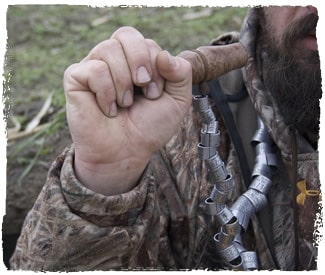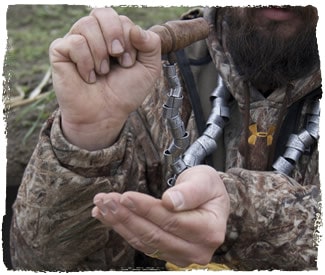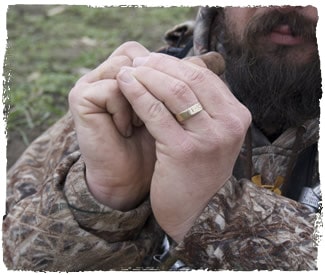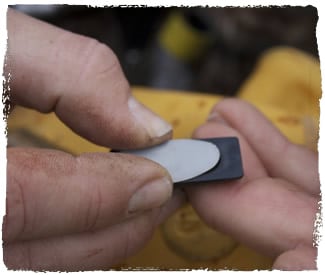BILL SAUNDERS CALLS & GEAR CALLING & TUNING TIPS
HOW TO HOLD A GOOSE CALL

To hold call wrap thumb and index finger around very end of the exhaust, making sure not to cover any part of the exhaust. This is your “on” hand and in most cases is your dominant hand.

Bring fingers down to create a loose fist, this creates back pressure. I then bring my middle finger up to allow sound to escape, by raising and lowering your middle finger you can change tone.

Your “off” hand will then create a cup as if you were going to hold water. The depth of the cup will change the tone of the call and should be experimented with to find different tones.

I then bring the cupped/off hand up to the “on” hand and rest the “off” hand finger tips on the middle knuckles of the “on” hand. This creates my most commonly used hand position.

Here is a easy way to line up the “on” and “off” hands to get your grip, line up your thumbs so they rest next to each other.

For loud calling and hailing distant birds I use this open hand position to create a megaphone. This technique is very loud and can be heard at well over a mile away.
HOW TO TUNE A GOOSE CALL

To remove guts (tone trough, wedge and reed) from insert push straight down on tone trough and push out exhaust end of insert. Do not twist, bite or use pliers, this can damage sounding surface.

Place the reed with the shaved side up, if reed is not shaved the natural bow of the reed should be set with the belly of the bow placed on the tone trough. Move reed into position so it comes to the end of the tone channel.

Push down on reed and make sure tip of reed does not hit tone trough as it drops into the channel. The closer the reed is to the end of the channel, the more responsive the call will be. To create a hollow sound you can pull the reed back slightly, this will make call harder to operate, but is preferred by some callers.

While holding reed in place with thumb, place wedge on top of reed. For a deeper tone wedge should be set even or slightly behind tuning line on wedge. For higher pitch wedge should be placed in front of tuning line. Reed should not change position.

Now that all parts are set in desired location, push parts in with even steady pressure. Notice grip, this ensures parts do not slip or move.

Push parts in until they are snug, do not push in too tight (this could damage parts). Tone can also be affected by how far you push the parts into the insert. For cleaner sound push in further, in turn for more buzz push in less.

Finished with tune. After you have the call tuned the the way you like it may be helpful to mark the parts locations in relation to each other with permanent marker. If you have any questions contact the shop at (509)582-0190
CALLING BASICS
- Keep your tongue in an anchored position below your bottom teeth at the gum line.
- To get a good goosey buzz I suggest humming your lowest base note as you blow your call. You can change tone by humming high or low pitch or not humming at all.
- Some callers may find using the tip of your tongue a easier method, in that case replace the reference word K with a T. example ik, ook will now be it, oot.
- Hold the call so your lips create a complete seal to ensure full air flow.
- To avoid loss of parts keep on a double lanyard.
- In cold weather or when on the move keep call tucked in your coat.
- If you should get something under the reed try blowing the opposite direction, flushing with water or running a dollar bill under the reed.
- Keep call clean, flush with warm water, running water from the exhaust out the mouth piece
These are only suggestions you may find a variation of this method works better for you.
SOME HISTORIES ARE WRITTEN IN BLOOD…


